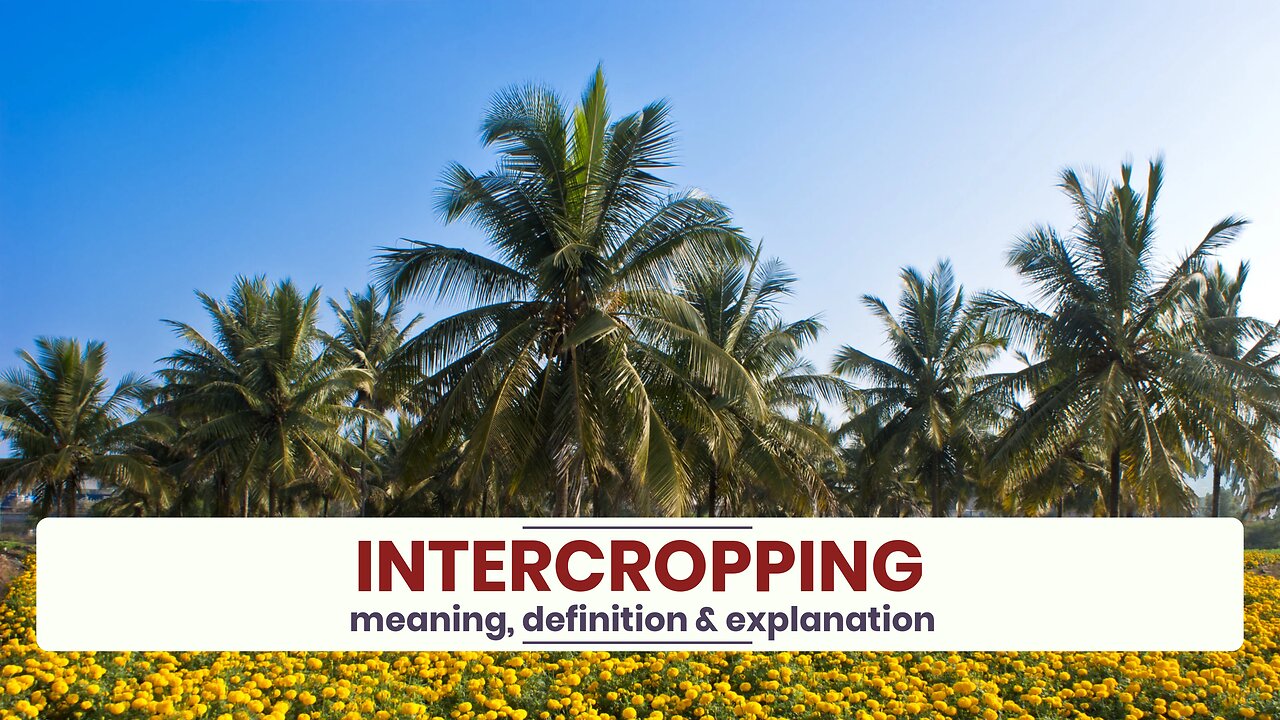Premium Only Content

What is INTERCROPPING?
✪✪✪✪✪
http://www.theaudiopedia.com
✪✪✪✪✪
What does INTERCROPPING mean? INTERCROPPING meaning - INTERCROPPING definition - INTERCROPPING explanation. What is the meaning of INTERCROPPING? What is the definition of INTERCROPPING? What does INTERCROPPING stand for? What is INTERCROPPING meaning? What is INTERCROPPING definition?
Intercropping is a multiple cropping practice involving growing two or more crops in proximity. The most common goal of intercropping is to produce a greater yield on a given piece of land by making use of resources that would otherwise not be utilized by a single crop. Careful planning is required, taking into account the soil, climate, crops, and varieties. It is particularly important not to have crops competing with each other for physical space, nutrients, water, or sunlight. Examples of intercropping strategies are planting a deep-rooted crop with a shallow-rooted crop, or planting a tall crop with a shorter crop that requires partial shade. Inga alley cropping has been proposed as an alternative to the ecological destruction of slash-and-burn farming.
When crops are carefully selected, other agronomic benefits are also achieved. Lodging-prone plants, those that are prone to tip over in wind or heavy rain, may be given structural support by their companion crop. Creepers can also benefit from structural support. Some plants are used to suppress weeds or provide nutrients. Delicate or light-sensitive plants may be given shade or protection, or otherwise wasted space can be utilized. An example is the tropical multi-tier system where coconut occupies the upper tier, banana the middle tier, and pineapple, ginger, or leguminous fodder, medicinal or aromatic plants occupy the lowest tier.
Intercropping of compatible plants also encourages biodiversity, by providing a habitat for a variety of insects and soil organisms that would not be present in a single-crop environment. This in turn can help limit outbreaks of crop pests by increasing predator biodiversity. Additionally, reducing the homogeneity of the crop increases the barriers against biological dispersal of pest organisms through the crop.
The degree of spatial and temporal overlap in the two crops can vary somewhat, but both requirements must be met for a cropping system to be an intercrop. Numerous types of intercropping, all of which vary the temporal and spatial mixture to some degree, have been identified. These are some of the more significant types:
- Mixed intercropping, as the name implies, is the most basic form in which the component crops are totally mixed in the available space.
- Row cropping involves the component crops arranged in alternate rows. Variations include alley cropping, where crops are grown in between rows of trees, and strip cropping, where multiple rows, or a strip, of one crop are alternated with multiple rows of another crop. A new version of this is to intercrop rows of solar photovoltaic modules with agriculture crops. This practice is called agrivoltaics.
- Temporal intercropping uses the practice of sowing a fast-growing crop with a slow-growing crop, so that the fast-growing crop is harvested before the slow-growing crop starts to mature.
- Further temporal separation is found in relay cropping, where the second crop is sown during the growth, often near the onset of reproductive development or fruiting, of the first crop, so that the first crop is harvested to make room for the full development of the second.
-
 1:52
1:52
The Audiopedia
10 months agoWhat is EXECUTIVE DIRECTOR?
531 -
 LIVE
LIVE
Barry Cunningham
1 hour agoWATCH LIVE: PRESIDENT TRUMP SPEECH ON INVESTING IN AMERICA!
572 watching -
 LIVE
LIVE
Dr Disrespect
5 hours ago🔴LIVE - DR DISRESPECT - WARZONE NUKE - WILL IT EXPLODE?
2,980 watching -
 1:58:53
1:58:53
Darkhorse Podcast
4 hours agoThe 274th Evolutionary Lens with Bret Weinstein and Heather Heying
21.4K19 -
 30:09
30:09
Iggy Azalea
1 hour ago $0.45 earnedplaying motherland
2.54K -
 LIVE
LIVE
StoneMountain64
3 hours ago1st stream BACK! Arc Raiders BRAND new exclusive alpha early look
275 watching -
 2:12:09
2:12:09
The Quartering
4 hours agoUkraine Mineral Deal Today, China Suffering From Tariffs, Epstein Suicide Letter, Meme Ban!
113K37 -
 1:17:36
1:17:36
The White House
4 hours agoPress Secretary Karoline Leavitt Briefs Members of the New Media, Apr. 30, 2025
49.2K24 -
 LIVE
LIVE
RiftTV/Slightly Offensive
2 hours ago $3.07 earnedWitnessing The COMPLETE COLLAPSE of American Society | Guests: Gavin McInnes and Anthony Cumia
857 watching -
 LIVE
LIVE
The HotSeat
1 hour agoBuffalo Schools PROTECTED PREDATORS – Angry Cops Exposes Child Abuse Cover-Up from Hell!
592 watching